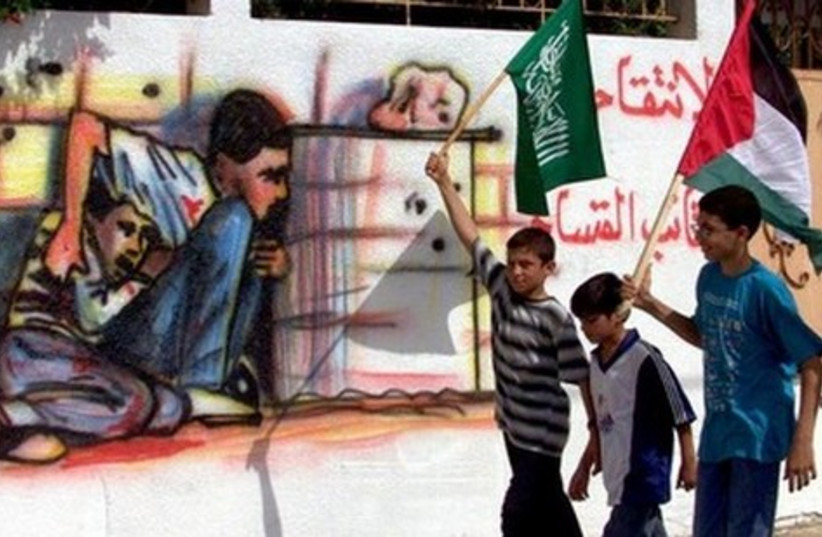Early in this deeply researched and absorbing work, Prof. Richard Landes frankly admits that it is open to being written off as “the rantings of an ‘Israel-firster,’ a Zionist propagandist.”
But, he argues, if he has assessed and analyzed the issues correctly, global opinion has been consistently misled by the media about the truth of the Arab-Israel dispute, that this lethal journalism has fostered a continuous rise in antisemitism in the West, and that blinkered and largely unaware, the civilized world is facing an insidious enemy intent on its destruction.
Landes singles out two incidents in the early years of the century that starkly illustrate how eager the media were to condemn Israel as brutal, inhumane and immoral, and how reluctant many journalists were to correct the record when the truth was eventually revealed.
The Muhammad al-Dura incident: Palestinian propaganda against Israel
On September 30, 2000, a French TV channel broadcast footage filmed by a Palestinian cameraman that purported to show a defenseless 12-year-old Palestinian boy, Muhammad al-Durah, and his father under fire from Israeli troops, and the boy being hit. The story that emerged maintained that the boy had been targeted and shot in cold blood.
A torrent of condemnation and anti-Israel invective followed. Years later, it emerged that the incident had most likely been staged for the camera, that faking such incidents for Palestinian propaganda purposes was common, and that Western journalists were well aware of the practice.

Even so, the TV journalist responsible for the al-Durah story, while acknowledging that Palestinians stage incidents for the camera “all the time,” refused to retract his story, on the grounds, Landes thinks, that false or not, he believed it conveyed a deeper truth. One journalist described such fakes as “an authentic symbol of the Israeli occupation.”
On April 1, 2002, Israeli troops, having first gone house to house warning civilians to leave, attacked a five-block area within the Jenin refugee camp. For two weeks, while terrorists were being flushed out, the world’s media were barred from the area, and speculation ran riot. Journalists filed stories of civilians being slaughtered in their thousands, of mass executions, bloodbaths and mass graves. A respected UK writer accused Israel of genocide.
Even when journalists were allowed to re-enter Jenin and found no evidence of the lurid claims, few changed their stories. A few months later, it emerged that far from the thousands of slaughtered civilians confidently and widely reported, the number of Palestinians killed in the operation had been at most 56, of whom 40 were combatants, while 26 Israeli soldiers had also lost their lives.
In short, the evidence assembled by Landes substantiates his denunciation of the journalistic consensus that consistently casts Israel as the irredeemable villain, while it believes virtually everything the Palestinians claim.
LANDES HAS compiled what he calls a Palestinian Media Protocol – the approach to news reporting that will raise no objections from Palestinian propagandists. Stories must portray Palestinians as victims resisting Israeli oppression, while Israel must never be portrayed sympathetically.
He illustrates the protocol in action. When a Palestinian who murdered two Israeli civilians in Jerusalem was shot, BBC news reported: “Palestinian shot dead after Jerusalem attack kills two.” When Israeli troops hit a Hamas weapons depot, the explosion caused an adjacent house to collapse, killing a mother and her child. The UK Independent headlined the story: “Israel kills pregnant mother and her baby in revenge attacks.”
In considering the deep roots of the Arab-Israel impasse, Landes contrasts two very different cultures. While the Western world, by and large, evolved positive, progressive, egalitarian societies, many African and Middle East nations developed cultures that Landes describes as “shame-honor.” In these societies, a man without honor is contemptible, despised. If someone kills his kin, he must retaliate in blood. Landes postulates that the Arab opposition to Israel is a case study in shame-honor.
For some 13 centuries, Jews in Muslim societies were classed as dhimmi, accepting public degradation and legal inferiority in order to avoid persecution. Arab and Muslim honor lay in their domination and humiliation of their dhimmi. To the honor-driven Arab mind, the very idea that their erstwhile dhimmi had set up a sovereign state on Arab land was intolerable, and the establishment of the State of Israel was a deep psychological trauma.
The humiliation was only deepened by Israeli victories in the subsequent united Arab attacks. Landes maintains that the West has never fully appreciated the shame-honor phenomenon that motivates Arab reaction to the conflict and the numerous failed peace initiatives.
Landes is equally convinced that the West fails to appreciate that extremist Muslim forces are engaged on a global jihad, determined to convert the world to Islam. They intend to destroy the liberal democracies from within, using their own institutions to do so. Religious freedom allows the spread of radical mosques. Freedom of speech permits the spread of radical ideas. The legal system presumes innocence; proving guilt is replete with obstacles.
Landes has no answers to the dire situation he reveals. He asks what it would take to change deeply embedded false perceptions or to spread awareness of the real dangers facing the democratic world but admits that his suggestions are unrealistic. He can imagine what such a sea change could be like but holds out no hope that it is possible.
However, to the question he poses in his title – Can “The Whole World” Be Wrong? – his closely reasoned, gripping and revelatory work returns a clear answer. Yes.
CAN “THE WHOLE WORLD” BE WRONG?
By Richard Landes
550 pages; $25.95
